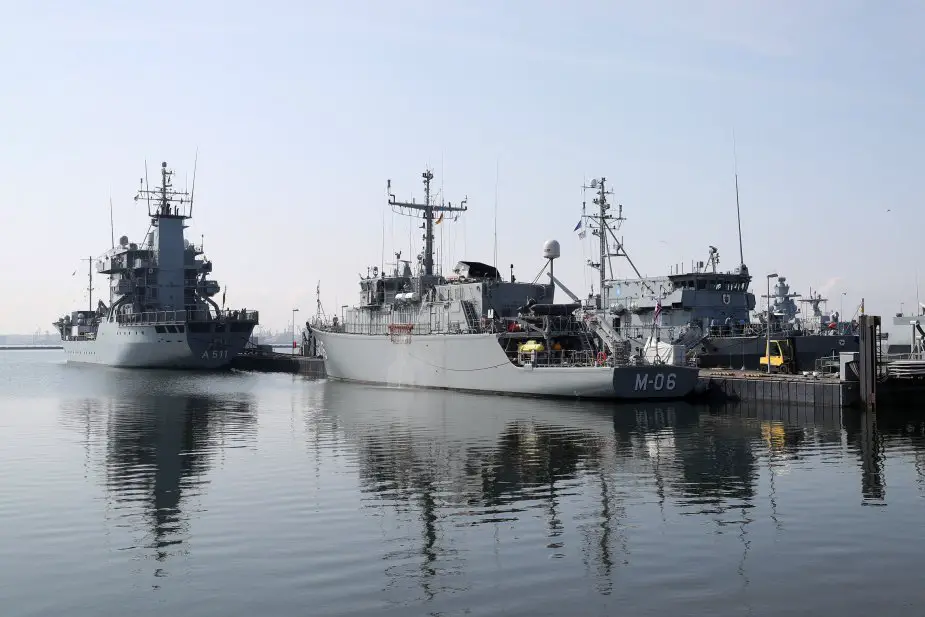Breaking news
Standing NATO Mine Countermeasures Group 1 completes mine hunting exercise.
According to a press release published by NATO on July 27, 2021, Standing NATO Mine Countermeasures Group One (SNMCMG1) conducted Operation Bottom Search German waters near Eckernförde from 19-23 July 2021. The Operation was officially known as Marinekommando Unterabteilung Geoinformation Dezernat Maritime Geo-Unterstützung (MWDC).
Follow Navy Recognition on Google News at this link
 FGS Elbe (Germany) and mine countermeasures vessels FGS Homburg (Germany) and LVNS Talivaldis (Latvia). (Picture source: Deutsche Marine)
FGS Elbe (Germany) and mine countermeasures vessels FGS Homburg (Germany) and LVNS Talivaldis (Latvia). (Picture source: Deutsche Marine)
The objective of the operation was to reduce risk posed by sea mines to maritime communities and traffic of the Baltic Sea, and provide enhanced training in mine countermeasures operations to SNMCMG1 participating units.
Following the first and second World Wars several ammunition dumping areas were established in the area. Over time, ordnance drifted from the original sites or became naturally buried in sand and mud. To this day, the presence of historical sea mines and other explosive remnants of war poses a threat to maritime traffic in the Baltic Sea.
Cumulatively SNMCMG1 performed 141 hours of bottom search operations and covered an area of ten square nautical miles. During the operation, the group located and identified one 1940s artillery shell and two sea mines, confirming that a significant amount of military munitions remain present in this area of the Baltic Sea from the two World Wars. While mapping the ocean bottom SNMCMG1 also located and mapped two shipwrecks that were unable to be identified due to their deteriorated conditions.
To locate the maximum amount of objects, SNMCMG1 units use hull-mounted or side scan sonar equipment to detect objects on the sea bed. The objects are then further identified by divers or remotely operated underwater vehicles.
SNMCMG1 provided all collected data of the area to the German Mine Warfare Data Center (MWDC) to facilitate their efforts to map the sea bed in order to ensure the safety of navigation within German territorial waters. All historical ordnance search activities were executed in close coordination and consent of the German authorities.
During the operation, SNMCMG1 consisted of the flagship FGS Elbe (Germany) and mine countermeasures vessels FGS Homburg (Germany) and LVNS Talivaldis (Latvia).
The Tripartite class is a class of minehunters developed from an agreement between the navies of Belgium, France and the Netherlands. A total of 35 ships were constructed for the three navies. The class was constructed in the 1980s–1990s in all three countries, using a mix of minehunting, electrical and propulsion systems from the three-member nations.
In 2007, the Latvian Naval Forces acquired five ships (including LVNS Talivaldis) from the Netherlands which had been taken out of service at the beginning of the decade.
In the Royal Netherlands Navy, the Tripartite is known as the Alkmaar class. The Alkmaars were originally of similar design to the Belgian and French versions, with a standard displacement of 520 tonnes (510 long tons) and 553 tonnes (544 long tons) at full load. The displacement later increased to 571 tonnes (562 long tons) standard and 605 tonnes (595 long tons) at full load and then 630 tonnes (620 long tons) standard and 660 tonnes (650 long tons) at full load.
The 20 mm gun that was initially mounted was removed, leaving only three 12.7 mm machine guns. Beginning in 2003, the remaining Dutch Alkmaar-class minehunters were upgraded with improved electronics, including Atlas Elektronik INCMS combat data system, Thales 2022 Mk III hull-mounted sonar, Atlas Seafox Mine Identification and Disposal System and a Double Eagle Mk III Mod 1 ROV.





























